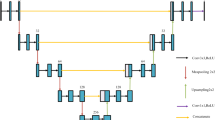Abstract
Road crack detection is an important step in urban road maintenance. Manual detection is both time-consuming and costly. Machine detection has gradually become the primary method in road maintenance due to the advantages of automation, stability and reliability. Therefore, this paper proposes a new UNet based on multi-residual attention (MRA-UNet), which is used in road crack segmentation. This paper proposes the multi-scale residual module which is used to capture crack information of different scales in the down-sampling path, and the dual-attention module is used to recover semantic information in the up-sampling path. The dual attention module in this paper is plug-and-play. At the same time, the MRA-UNet is evaluated on two public datasets, namely the CFD and EdmCrack600. Compared with some previous semantic segmentation networks, the proposed MRA-UNet achieved the good results of F1 score, IoU, computational volume and inference speed, balancing the accuracy and speed of segmentation. Especially in terms of speed, this is more conducive to the practical application and ground deployment of the backorder, which can be applied to the road maintenance projects.









Similar content being viewed by others
Availability of data and materials
The research has used publicly available dataset.
References
Ni, F., Zhang, J., Chen, Z.: Pixel-level crack delineation in images with convolutional feature fusion. Struct. Control. Health Monit. 26(1), 2286 (2019)
Dung, C.V., et al.: Autonomous concrete crack detection using deep fully convolutional neural network. Autom. Constr. 99, 52–58 (2019)
Liu, Z., Cao, Y., Wang, Y., Wang, W.: Computer vision-based concrete crack detection using u-net fully convolutional networks. Autom. Constr. 104, 129–139 (2019)
Dong, Y., Wang, J., Wang, Z., Zhang, X., Gao, Y., Sui, Q., Jiang, P.: A deep-learning-based multiple defect detection method for tunnel lining damages. IEEE Access 7, 182643–182657 (2019)
Mei, Q., Gül, M.: A cost effective solution for road crack inspection using cameras and deep neural networks. arXiv preprint arXiv:1907.06014 (2019)
Lau, S.L., Chong, E.K., Yang, X., Wang, X.: Automated pavement crack segmentation using u-net-based convolutional neural network. IEEE Access 8, 114892–114899 (2020)
Qiao, W., Liu, Q., Wu, X., Ma, B., Li, G.: Automatic pixel-level pavement crack recognition using a deep feature aggregation segmentation network with a scse attention mechanism module. Sensors 21(9), 2902 (2021)
Liu, Y., Yao, J., Lu, X., Xie, R., Li, L.: Deepcrack: a deep hierarchical feature learning architecture for crack segmentation. Neurocomputing 338, 139–153 (2019)
Zhang, Z., Liu, Q., Wang, Y.: Road extraction by deep residual u-net. IEEE Geosci. Remote Sens. Lett. 15(5), 749–753 (2018)
Ronneberger, O., Fischer, P., Brox, T.: U-net: convolutional networks for biomedical image segmentation. In: International Conference on Medical Image Computing and Computer-Assisted Intervention, pp. 234–241 (2015). Springer
Zhou, Z., Siddiquee, M.M.R., Tajbakhsh, N., Liang, J.: Unet++: redesigning skip connections to exploit multiscale features in image segmentation. IEEE Trans. Med. Imaging 39(6), 1856–1867 (2019)
Ibtehaz, N., Rahman, M.S.: Multiresunet: rethinking the u-net architecture for multimodal biomedical image segmentation. Neural Netw. 121, 74–87 (2020)
Oktay, O., Schlemper, J., Folgoc, L.L., Lee, M., Heinrich, M., Misawa, K., Mori, K., McDonagh, S., Hammerla, N.Y., Kainz, B., et al.: Attention u-net: learning where to look for the pancreas. arXiv preprint arXiv:1804.03999 (2018)
Huang, G., Zhu, J., Li, J., Wang, Z., Cheng, L., Liu, L., Li, H., Zhou, J.: Channel-attention u-net: channel attention mechanism for semantic segmentation of esophagus and esophageal cancer. IEEE Access 8, 122798–122810 (2020)
Xia, H., Ma, M., Li, H., Song, S.: Mc-net: multi-scale context-attention network for medical ct image segmentation. Appl. Intell. 52, 1–12 (2021)
Li, X., Wang, W., Hu, X., Yang, J.: Selective kernel networks. In: Proceedings of the IEEE/CVF Conference on Computer Vision and Pattern Recognition, pp. 510–519 (2019)
Fu, J., Liu, J., Tian, H., Li, Y., Bao, Y., Fang, Z., Lu, H.: Dual attention network for scene segmentation. In: Proceedings of the IEEE/CVF Conference on Computer Vision and Pattern Recognition, pp. 3146–3154 (2019)
Woo, S., Park, J., Lee, J.-Y., Kweon, I.S.: Cbam: convolutional block attention module. In: Proceedings of the European Conference on Computer Vision (ECCV), pp. 3–19 (2018)
Getreuer, P.: Automatic color enhancement (ace) and its fast implementation. Image Process. 2, 266–277 (2012)
Acknowledgements
This work was supported in part by the Science Technology Commission Project: intelligent identification and optimization of the control strategy for shield tunneling state (No. 18DZ1205502) and supported by the Science Technology Commission Project: risk analysis of urban viaduct traffic safety (No. 18DZ1201204).
Author information
Authors and Affiliations
Corresponding author
Ethics declarations
Conflict of interest
The authors have no conflicts of interest to declare that are relevant to the content of this article.
Ethics approval
Approval.
Consent to participate
Approval.
Consent for publication
Approval.
Code availability
Not applicable.
Additional information
Publisher's Note
Springer Nature remains neutral with regard to jurisdictional claims in published maps and institutional affiliations.
Rights and permissions
Springer Nature or its licensor (e.g. a society or other partner) holds exclusive rights to this article under a publishing agreement with the author(s) or other rightsholder(s); author self-archiving of the accepted manuscript version of this article is solely governed by the terms of such publishing agreement and applicable law.
About this article
Cite this article
Gao, X., Tong, B. MRA-UNet: balancing speed and accuracy in road crack segmentation network. SIViP 17, 2093–2100 (2023). https://doi.org/10.1007/s11760-022-02423-9
Received:
Revised:
Accepted:
Published:
Issue Date:
DOI: https://doi.org/10.1007/s11760-022-02423-9




